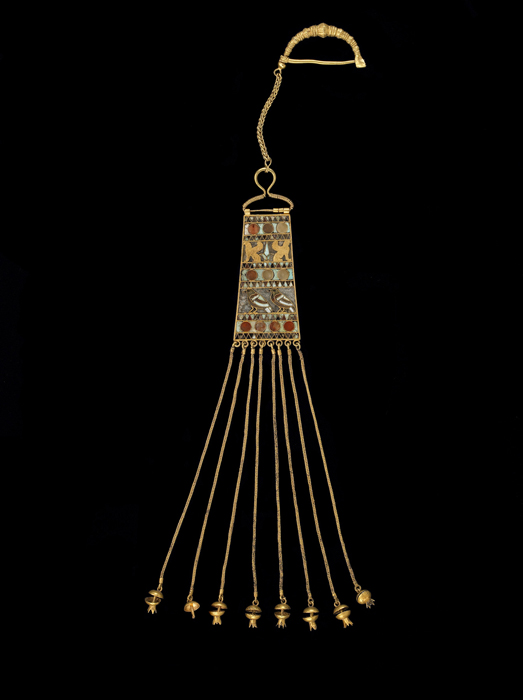POLYCHROME PECTORAL WITH GRIFFINS AND BIRDS
From Grave 6, Achaemenid and Colchian, first half of the 4th century B.C. GNM: 11-974:13

This colorful pectoral exemplifies a remarkable confluence of cultures. It was found in the chest area of the principal deceased from Grave 6 – the honorand was a 25-year old woman whose rich funerary goods included Achaemenid (Persian) and Rhodian (East Greek) imports. In fact, it is the presence of the Achaemenid bracelets that suggest the dating of the grave to the first half of the 4th century B.C.
The pectoral consists of three distinct elements: 1) a gold fibula that attaches by means of a gold chain to a gold clip: 2) a trapezoidal pendant decorated in cloisonnes filled with glass, turquoise, and carnelian; and 3) long chains with pomegranate terminals.
The gold fibula attached to the gold clip indicates that this jewel was probably fastened to clothing – its granulation is of an Anatolian type. The trapezoidal pectoral seems related to Egyptian pectorals that were worn around the neck and featured a counterweight of a similar shape that hung at the back. The techniques and motifs are also Egyptian – an upper band of back-to-back griffins (with a lotus between them) and a lower band consisting of two birds, separated by alternating rows of triangles and discs. And yet the Persians also used this form and polychrome and the adoption of Egyptian motifs is typical of their production. Lastly, the hanging chains are common in Colchian jewelry and the pomegranate is a beloved motif of Classical jewelers.
It would seem, then, to be an Egyptianizing Persian pendant, adapted for Colchian use with the addition of the Anatolian fibula and the Colchian type chains terminating in Classical motifs.